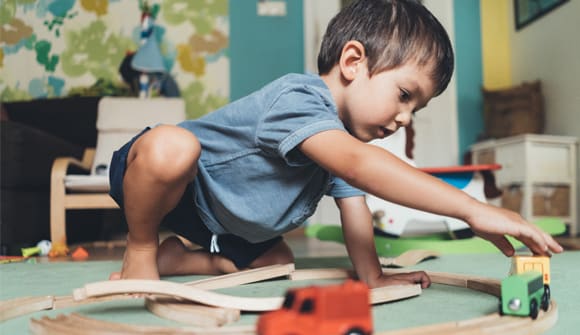Imaginary friendships
What parents should know about their child’s invisible bestie.
Article Author: Katie McPherson
Article Date:

“You’re sitting on him!”
As you leap up from the dining room chair and apologize to your child for squishing his or her imaginary friend (again), you’re probably wondering how long this phase will last. When your child has a make-believe friend — whether large, small, furry, eight-legged or whatever else — it can be a bit trying for parents.
But good news: Vicki VanGundy, licensed mental health counselor with Baptist Behavioral Health and Wolfson Children’s Behavioral Health, said having one is a sign your kiddo is highly creative, and studies show he or she likely will be as an adult.
“Imaginary friends are a normal part of child development. They serve as companions and entertainment, and help in the development of creative play and thinking. Children learn social skills through imaginary and real friendships, like how to share, be patient with others, wait one’s turn and have empathy for others,” she said.
VanGundy shared what parents should know about their child’s invisible companion(s).
They’re surprisingly common.
More than half of all children have a make-believe bestie.
“Research has found 65% of children will have an imaginary friend at some time,” said VanGundy. “Children between the ages of 3 and 5 are the most common age group to have one, with girls outnumbering boys.”
She added that first-born and only children are more likely to create imaginary friendships.
So, how long is your kid’s pink and purple leopard or two-headed monster going to hang around? Well, it differs for everyone, but VanGundy said they usually disappear around elementary school.
“Some imaginary friends may ‘live’ in the child’s life for a few months to a few years. These friendships for most children begin phasing out before or during the late elementary school grades. For others, these friendships can continue into the early teen years. As long as the imaginary friendships are not a roadblock to social and emotional growth, they can continue to be a healthy expression of creativity.”
They can help kids cope.
If your child has been through something stressful — which is more likely than ever thanks to the pandemic — you may have noticed he or she is using imagination to get through.
“These friends can be used as a coping mechanism to manage stress, anxiety or other life experiences that stir strong emotions,” VanGundy explained. “Children in foster care, those who have been through or witnessed trauma or abuse, or those who are experiencing a change in family dynamics may create an imaginary friend to assist in helping manage fears, anger and other emotions. Due to COVID-19 and schools being closed, many children have revisited former imaginary friendships or created new ones.”
They’re rarely a bad thing.
Although creating an imaginary friend is a normal, healthy experience in a child’s development, there are times when it may be cause for concern.
“Children who have experienced trauma may develop an imaginary friend as part of dissociation, which is a way to disconnect from the reality of the stressful event. If a child’s imaginary friend is encouraging him or her to say or do hurtful things to others, this might also be a time to be concerned,” VanGundy said. “If a parent has concerns regarding a change in their child’s behaviors, they should speak with their pediatrician or a therapist.”
They don’t come with a manual (until now).
Since only your child can see and know his or her imaginary friend, VanGundy shared a few guidelines for dealing with your little one and their companion:
- Talk to your child about his or her imaginary friend. What is their name? What types of food and hobbies does the friend enjoy? Where do they come from? Do they live in your home and, if so, where? (You’ll want to know this so you don’t dust or vacuum them away accidentally in front of your child.) The more you know about the imaginary friend, the more engaging conversations you can have with your child.
- You don’t need to remind your child that the friend is imaginary. Most children are aware of the difference between real and make-believe.
- If your child is blaming his or her behavior on the imaginary friend, you don’t have to play along. As with any time a child misbehaves, make sure he or she understands why the behavior is unacceptable and what would be a better choice.
- It’s OK to pretend. If your child asks to have an extra place set at the dinner table, or reminds you not to sit somewhere because their friend is there, you can play along. Having these moments with your child and their imaginary friend allows you to create memories with and for your child.
If you’re concerned about a stressful event in your child’s life or their imaginary friend, Baptist and Wolfson Children's Behavioral Health can help. Call 904.376.3800 and a patient care coordinator will connect you with the right provider for you.



